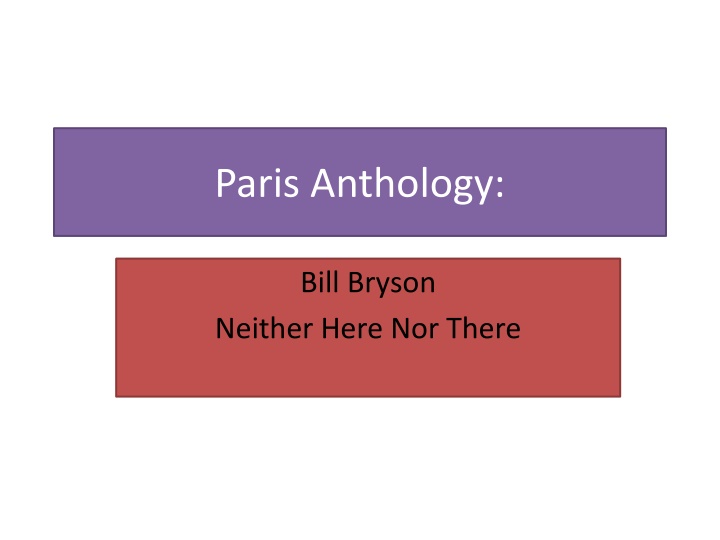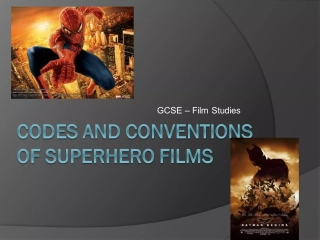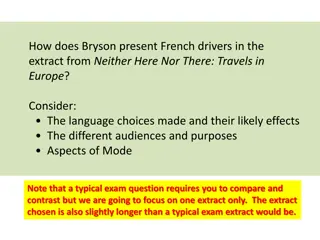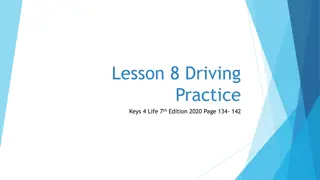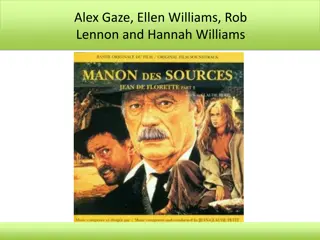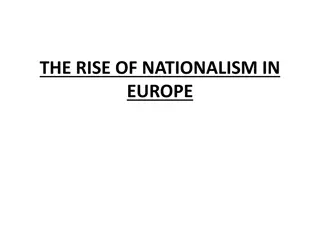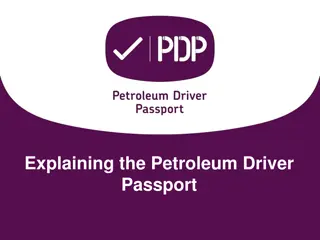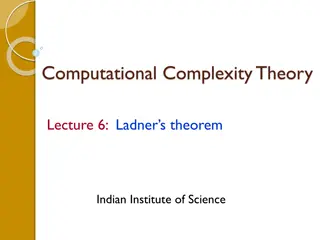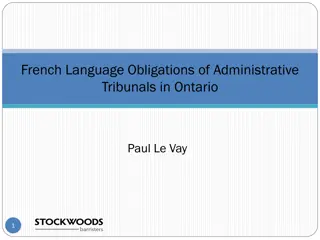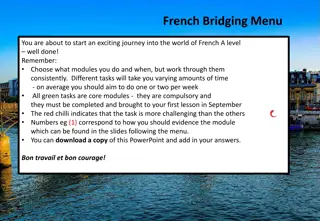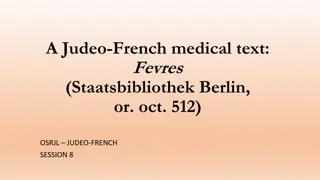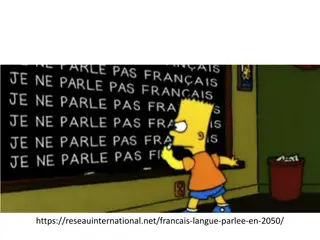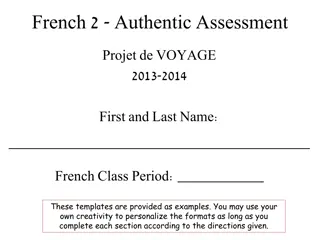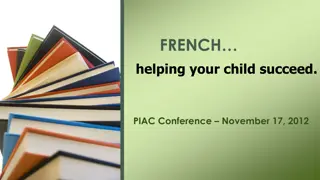Bryson's Portrayal of French Drivers in "Neither Here Nor There: Travels in Europe
In the extract, Bryson humorously criticizes French drivers for their aggressive and chaotic driving in Paris. He highlights the challenge pedestrians face due to excessive traffic and the historical reputation of French drivers. The narrative reflects Bryson's unique perspective on the cultural aspect of driving behavior in France and how it aligns with long-standing stereotypes.
Uploaded on Sep 10, 2024 | 3 Views
Download Presentation

Please find below an Image/Link to download the presentation.
The content on the website is provided AS IS for your information and personal use only. It may not be sold, licensed, or shared on other websites without obtaining consent from the author.If you encounter any issues during the download, it is possible that the publisher has removed the file from their server.
You are allowed to download the files provided on this website for personal or commercial use, subject to the condition that they are used lawfully. All files are the property of their respective owners.
The content on the website is provided AS IS for your information and personal use only. It may not be sold, licensed, or shared on other websites without obtaining consent from the author.
E N D
Presentation Transcript
Paris Anthology: Bill Bryson Neither Here Nor There
How does Bryson present French drivers in the extract from Neither Here Nor There: Travels in Europe? Consider: The language choices made and their likely effects The different audiences and purposes Aspects of Mode Note that a typical exam question requires you to compare and contrast but we are going to focus on one extract only. The extract chosen is also slightly longer than a typical exam extract would be.
To successfully address this question you need to: AO1 Identify language techniques and apply terminology Analyse language choices made by a writer and consider the likely effects AO3 Link language choices to the writer s purpose Identify the writer s point of view Address ideas of stereotyping and representation
By half-past eight Paris is a terrible place for walking. Theres too much traffic. A blue haze of uncombusted diesel hangs over every boulevard. I know Baron Haussmann made Paris grand place to look at, but the man had no concept of traffic flow. At the Arc de Triomphe alone thirteen roads come together. Can you imagine that? I mean to say, here you have a city with the world s most pathologically aggressive drivers drivers who in other circumstances would be given injections of thorazine from syringes the size of bicycle pumps and confined to their beds with leather straps and you give them an open space where they can all try to go in any of thirteen directions at once. Is that asking for trouble or what? It s interesting to note that the French have had this reputation for bad driving since long before the invention of the internal combustion engine. Even in the eighteenth century British travellers to Paris were remarking on what lunatic drivers the French were, on the astonishing speed with which the carriages and people moved through the streets. It was not an uncommon sight to see a child run over and probably killed. I quote from The Grand Tour by Christopher Hibbert, a book whose great virtue is in pointing out that the peoples of Europe have for at least 300 years been living up to their stereotypes. As long ago as the sixteenth century, travellers were describing the Italians as voluble, unreliable and hopelessly corrupt, the Germans as gluttonous, the Swiss as irritatingly officious and tidy, the French as, well, insufferably French.
You also constantly keep coming up against these monumental squares and open spaces that are all but impossible to cross on foot. My wife and I went to Paris on our honeymoon and foolishly tried to cross the Place de la Concorde without first leaving our names at the embassy. Somehow she managed to get to the obelisk in the centre, but I was stranded in the midst of a circus maximus of killer automobiles, waving weakly to my dear spouse of two days and whimpering softly while hundreds and hundreds of little buff-coloured Renaults were bearing down on me with their drivers all wearing expressions like Jack Nicholson in Batman. It still happens now. At the Place de la Bastille, a vast open space dominated on its north-eastern side by a glossy new structure that I supposed to be the Paris branch of the Bradford and Bingley Building society but which proved upon closer inspection to be the new Paris opera house, I spent three-quarters of an hour trying to get from the rue de Lyon to the Rue de St-Antoine. The problem is that the pedestrian-crossing lights have been designed with the clear purpose of leaving the foreign visitor confused, humiliated and, if all goes to plan, dead.
Refer to your findings from the previous lesson where you explored LANGUAGE LEVEL 1. Can you identify useful examples of Language used by the writer in the extract provided? Bryson uses a lot of similes in his narrative. Write down as many examples as you can. Then, for each one, explain why you think he has used this imagery. What has he used as a comparison and why? What are the connotations of the comparison he uses and what does this imply? What is the effect of the comparison on readers? How does it help us to understand his viewpoint better? Wearing expressions like Jack Nicholson in Batman Draws on cultural reference of actor and film anyone familiar with either will appreciate the facial expression (manic) and the humour intended. WHAT?
To understand or appreciate the effects created you really need to understand what the writer s PURPOSE is... the WHY? of the text. What do you think Bryson s purpose is in this extract? How does he draw on stereotypes to fulfil his purpose and create his effects? WHY? WHAT?
Stereotypes and Schemas Representations of cultures and societies can be both positive and negative. In some instances these can present themselves as stereotypes. Schemas: A good example of stereotype can be seen in Bill Bryson s Neither Here nor There: Travels in Europe (p.14) where the narrator is writing about traffic congestion around the Arc de Triomphe. A set of assumptions and experiences held by a person that together comprise their knowledge base about a concept, person, place or event The stereotype that Bryson presents is informed by his own Paris schema both first and second-hand knowledge he has built up over years.
What language features would you select to support your response? Here you have a city with the world s most pathologically aggressive drivers drivers who in other circumstances would be given injections of thorazine from syringes the size of bicycle pumps and confined to their beds with leather straps and you give them an open space where they can all try to go in any of thirteen directions at once. (Neither Here not There: Travels in Europe p. 14) Stereotype: A broad representation of a group of people around exaggerated perceived common characteristics.
Here you have a city with the worlds most pathologically aggressive drivers drivers who in other circumstances would be given injections of thorazine from syringes the size of bicycle pumps and confined to their beds with leather straps and you give them an open space where they can all try to go in any of thirteen directions at once. (Neither Here not There: Travels in Europe p. 14) The stereotyping is evident in the pre-modified nouns e.g. most pathologically aggressive drivers which has strong negative connotations and an analogy of a mentally unwell person needing a heavy dose of thorazine (and anti-psychotic drug).
WHY? HOW HOW do they support the writer s purpose? Now revisit your language features WHAT? The writer conveys a very particular attitude towards French drivers - this may or may not be his personal viewpoint but it is a representation of French drivers nevertheless, and one he has deliberately chosen to exploit for laughs. http://www.designboom.com/weblog/images/images_2/2011/joyce/eleve_copy_7_slide_2.jpg
Before you start on your response, have a look at some exemplar answers with examiner commentary... Analysis of Language in Bryson s Neither Here Nor There travels in Europe Compare and contrast how the writers and speakers in these extracts present Paris. You should refer to both extracts in your answer and consider: the language choices made and their likely effects Neither Here nor There is a written text, therefore only displays features of written language. The lexical choices in this piece are obviously influenced by the purpose as it tries to sway the viewers' perception to make Paris seem less appealing to visitors. The use of slang such as the word shit makes it sound like Paris is dirty with nothing much there of any worth. The use of first person I also makes it believable as it is written by someone who has been there and has seen it for themselves. AO1 Terminology is generally applied but with sometimes limited support and exemplification from the texts. Some features are explained, as in the examination of pronouns and slang, but there is a limited range of terminology. There are glimmers of stronger understanding and engagement shown, such as in the discussion of slang but again this is limited. Typical of Level 2
You are ready to answer the question How does Bryson present French drivers in the extract from Neither Here Nor There: Travels in Europe? Consider: The language choices made and their likely effects The different audiences and purposes Aspects of Mode
To successfully address this question you need to: AO1 Identify language techniques and apply terminology Analyse language choices made by a writer and consider the likely effects AO3 Link language choices to the writer s purpose Identify the writer s point of view Address ideas of stereotyping and representation
